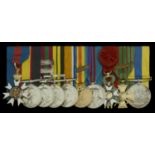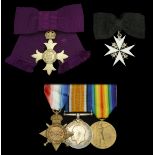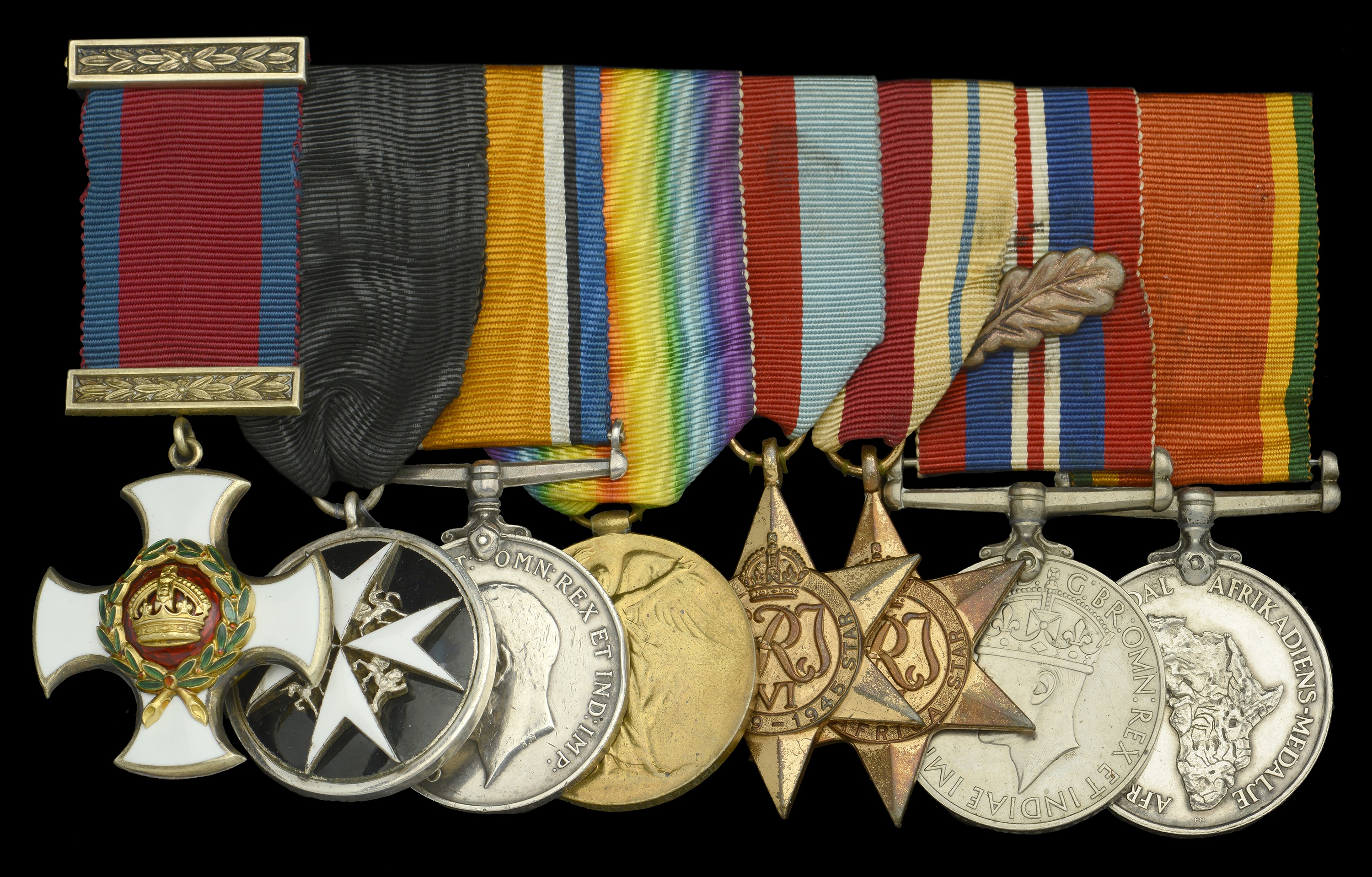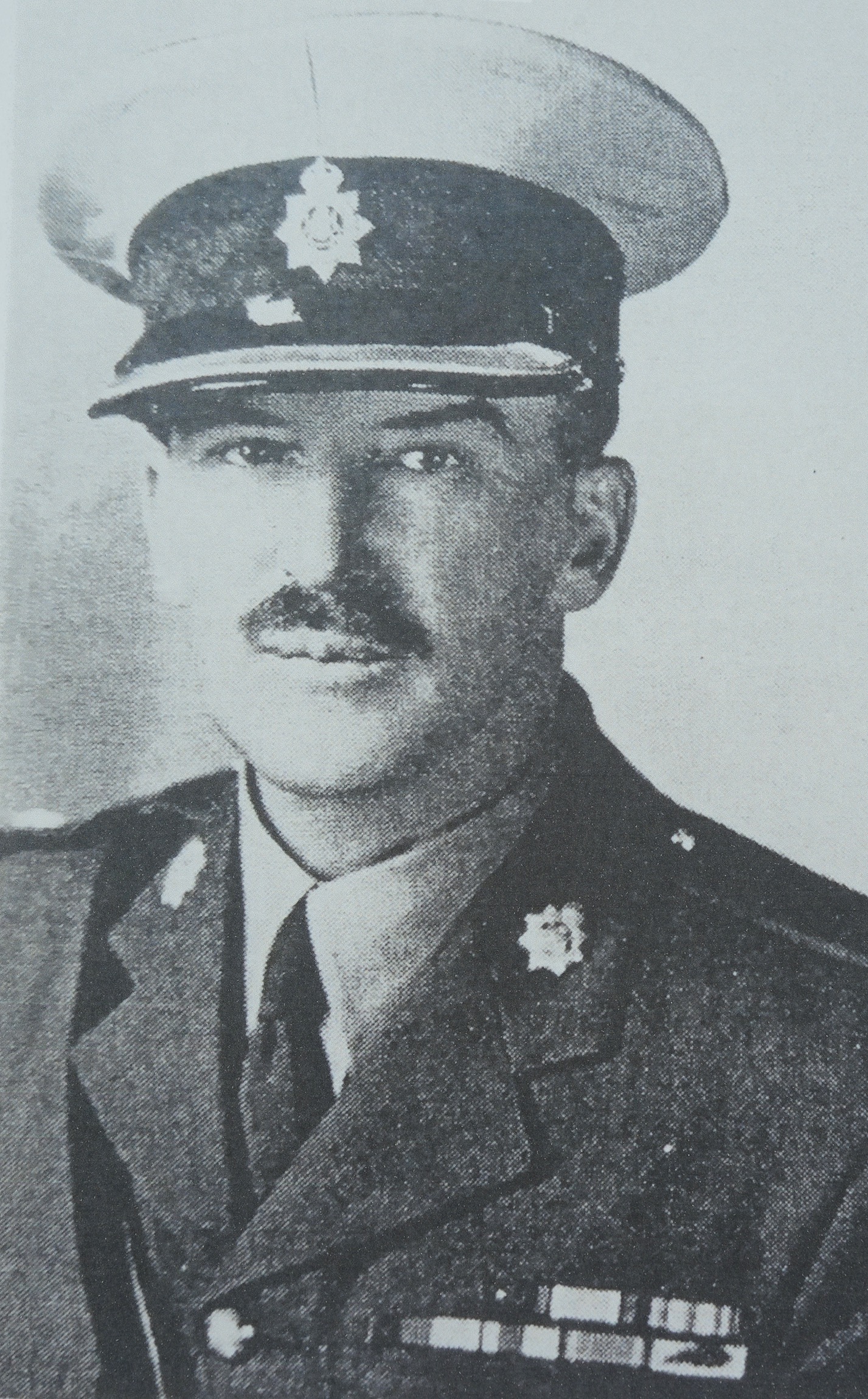A fine Second War ‘Tobruk’ Brigade Major’s D.S.O., Order of St. John, group of eight awarded to Major G. Bestford, 6th South African Infantry Brigade Headquarters, 2nd South African Division, a veteran of the Great War who was wounded in action whilst serving in the ranks of the 20th (Service) Battalion, Northumberland Fusiliers (1st Tyneside Scottish) on the First Day of the Battle of the Somme. Subsequently commissioned in to the 25th (Service) Battalion, Northumberland Fusiliers (1st Tyneside Irish), Bestford joined the South African Police after the Great War. He was mobilised for service during the Second War, and was taken Prisoner of War at the Fall of Tobruk on 21 June 1942. Bestford returned to the South African Police after the War, rose to District Commandant of Durban, and played a prominent role during the Royal Visit to South Africa in 1947 Distinguished Service Order, G.VI.R., silver-gilt and enamel, reverse officially dated ‘1946’, with integral top riband bar; The Order of St. John of Jerusalem, Serving Brother’s, breast badge, silver and enamels; British War and Victory Medals (2. Lieut. G. Bestford.) severe edge bruise to BWM; 1939-45 Star; Africa Star; War Medal 1939-45, with M.I.D. oak leaf; Africa Service Medal, Second War campaign awards all officially impressed (SAP195478 G. Bestford) mounted as originally worn, and subsequently additionally mounted on card for display, generally nearly very fine or better (8) £2,800-£3,200 --- D.S.O. London Gazette 19 December 1946: ‘In recognition of gallant and distinguished services at Tobruk in 1942.’ The original recommendation, given by Brigadier F. W. Cooper, O.C. 6 SA Bde, states: ‘From 10 Jan 42 to 21 Jun 42 Major Bestford was my [Brigadier F. W. Cooper, O.C. 6 SA Bde] Brigade Major. During that period he carried out his duties with entire disregard for his own comfort under what at times were very trying and dangerous conditions. He was mentioned in despatches for his work during operations at Sollum and Halfaya in Jan 42. During the period the brigade was attached to 1 S.A. Div. at Gazala - Mar - Apr 42 and during the period prior to the fall of Tobruk - Apr - Jun 42 his conduct was an example to all the work he put in over the six months, especially during the two vital days prior to the surrender, entitles him, in my opinion, to a D.S.O. for which I recommend him.’ Order of St John, Serving Brother London Gazette 2 January 1953. M.I.D. London Gazette 15 December 1942: ‘In recognition of gallant and distinguished services in the Middle East during the period November, 1941, to April, 1942.’ George Bestford was one of six sons born to Thomas Bestford, and was born in Gateshead, County Durham, in October 1897. He was educated at the local Higher Grade Secondary School, and at the age of 17 falsified his age to enlist in the 20th (Service) Battalion, Northumberland Fusiliers (1st Tyneside Scottish) on 26 October 1914. Bestford advanced to Sergeant, and served with the Battalion in the French theatre of War from 9 January 1916. The Battalion served as part of the 102nd Infantry Brigade on the Somme, and Bestford was wounded in action on 1 July 1916. On the latter date the Battalion were fighting in tandem with the 4th Tyneside Scottish: ‘Owing to the artillery barrage and the intense machine gun fire and the distance (800 yds) of no man’s land to be traversed, the two battalions were almost wiped out, though the positions of the dead showed that they pushed on to the enemy’s second line of trenches before they were annihilated.’ (Battalion War Diary refers) On the first day of the Battle of the Somme, the 20th Battalion suffered casualties of 16 officers and 337 other ranks killed, and 10 officers and 268 other ranks wounded. Bestford was amongst the latter, and was evacuated back to the UK. His South African Police service files show that he subsequently received a G.O.C.’s Divisional Commendation in recognition of his gallantry on 1 July 1916. Whilst recuperating from his wounds, Bestford would have received news that his brother William had been killed in action whilst serving with the Royal Engineers on 21 July 1916. The following month, Bestford transferred as Acting Company Quartermaster Sergeant to the 29th (Reserve) Battalion, Northumberland Fusiliers. He was subsequently posted to the 3rd Battalion, and then attached to the 84th Training Reserve Battalion at Hornsea. Major A. E. Ken recommended Bestford for a commission in March 1917: ‘This N.C.O. came very much under my observations, while at Home he attended several Courses of Instruction and on each one did very well indeed, on one occasion he came under the notice of the Brigadier who complimented him through his C.O. on his success... On Service he was even better, as a leader of men he is a success, I never knew him to shirk any danger or fatigues, and his coolness under Shell and Rifle fire is splendid. I regret to say his C.O. [Lieutenant Colonel C. Sillery] was killed as I knew that he had marked Sgt. Bestford out for distinction and no officers being left (All either killed or wounded) there was no one to put the recommendation forward. I think with a little training at a Cadet School he will make a very good Officer.’ After the requisite time with an Officer Cadet Battalion, Bestford was commissioned Second Lieutenant in the Northumberland Fusiliers in October 1917. He tragically lost another sibling when his eldest brother, Robert, was killed in action serving with the Durham Light Infantry on 1 December 1917. He was then posted to France for service with the 25th (Service) Battalion, Northumberland Fusiliers (2nd Tyneside Irish). After the War, he was attached as a Signalling Officer to the 2/4th Battalion, Oxfordshire and Buckinghamshire Light Infantry for service in Syria and Egypt. Bestford advanced to Lieutenant in May 1919, and relinquished his commission in March of the following year. He sailed for Natal, South Africa, in April 1921, and joined the South African Police in June 1921, and advanced from Constable to Captain, District Officer and Station Officer by June 1940. He was appointed Captain, 1st South African Police Battalion, Union Defence Force later that month, and was appointed to the Staff Headquarters, 6th Infantry (Police) Brigade. He embarked with the 2nd South African Division, and arrived in Egypt in June 1941. Serving across North Africa, at the Battles of Sollum and Halfaya, he was promoted Major in February 1942. Bestford served as Brigade Major, 6th South African Infantry Brigade Headquarters, and under constant attack from Rommel’s Afrika Korps, the Allied Forces retreated from the Gazala Line throughout May and June 1942. The Garrison at Tobruk became isolated and the majority of the 2nd South African Division was captured there en masse as Prisoners of War on 21 June following General Orders to surrender. Unable to escape, Bestford was taken prisoner by the Italians and interned at Campo 75 (Bari). He was subsequently transferred to Germany, and interned in Stalag VII-A, Stalag V-C, and finally at Oflag XII-B at Hadamar. Repatriated in April 1945, he was recommended retrospectively for the D.S.O. Bestford afterward returned to South Africa, and there resumed his employment with the South African Police. He was appointed Commanding Officer, Police Training Depot, Pretoria. During the Royal Visit of King George VI and Queen Elizabeth to South Africa in 1947, he had the honour of commanding the mounted escort and the Guard of Honour on special occasions throughout the tour. He was presented with his D.S.O. by the King at Voortrekkerhoogte, ...









